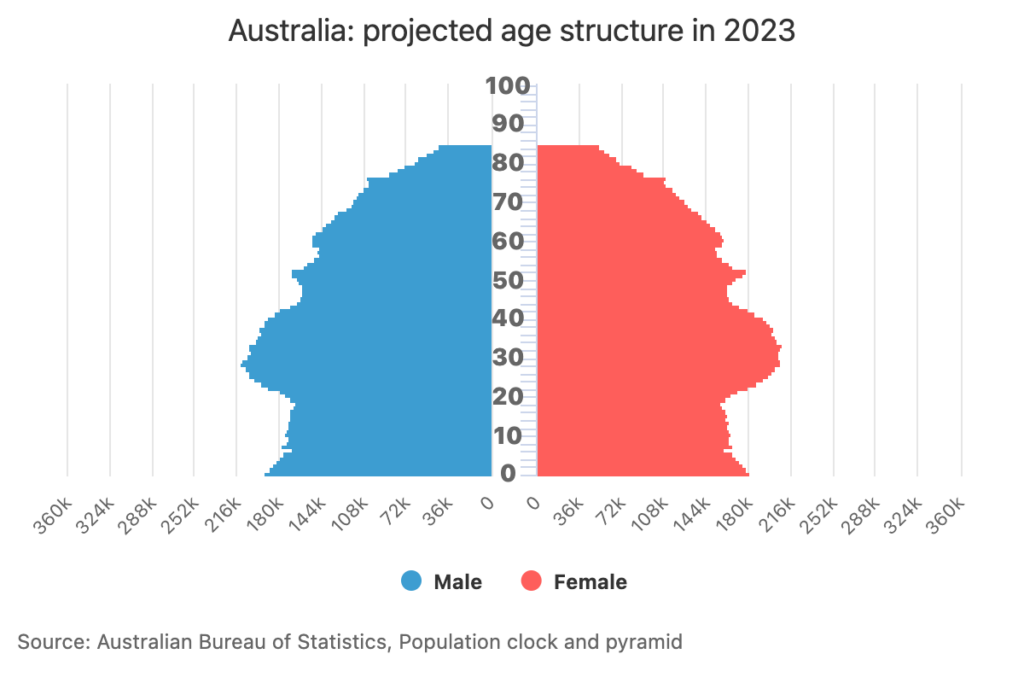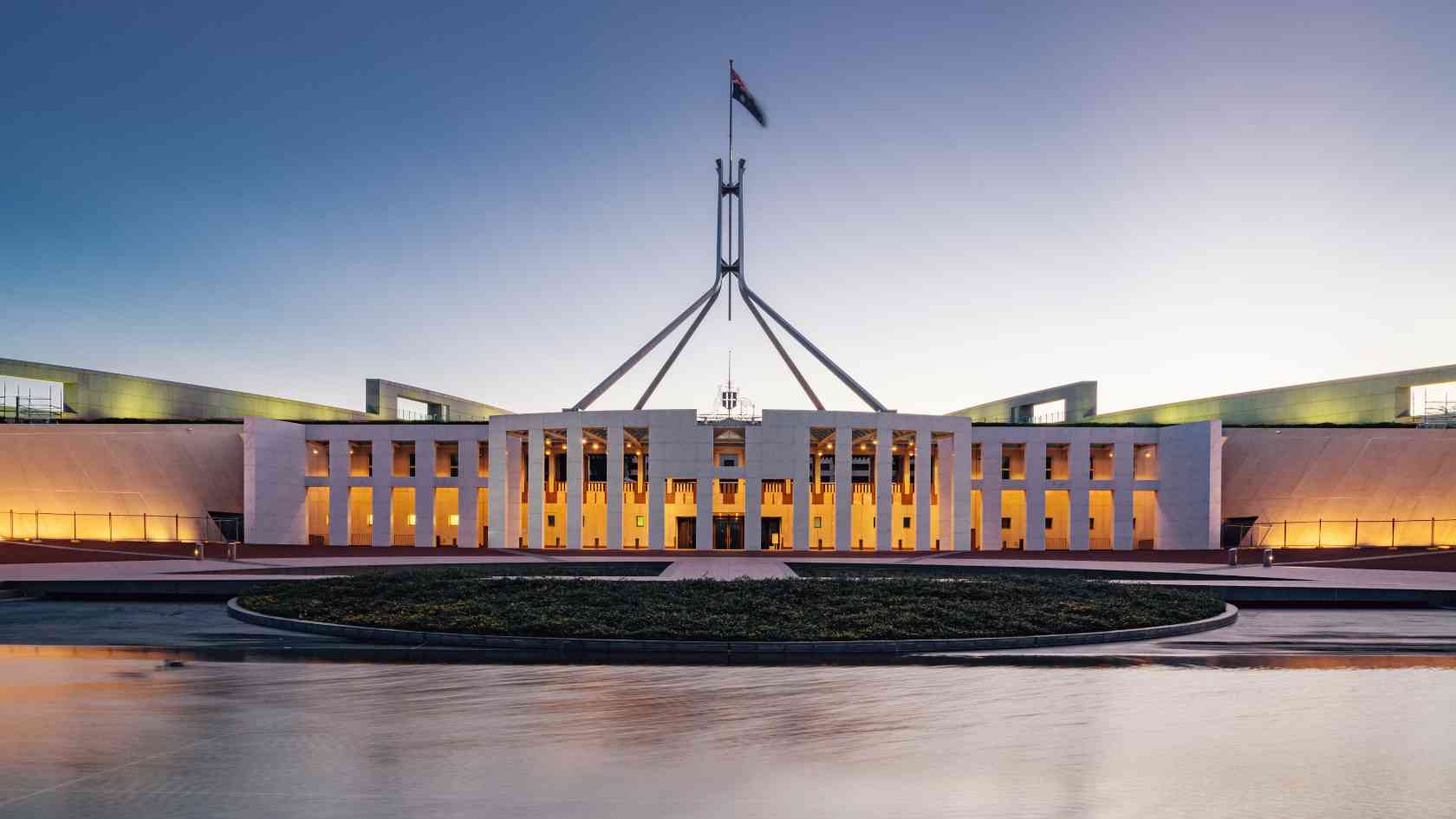The Australian Government released the latest Intergenerational Report 2023 (IR23), which provides an overview of the challenges and opportunities for the nation to 2063. It acknowledges that powerful forces will shape Australia’s economy, including population ageing, digital and data technology, climate change, surging demand for care services, and ever-present geopolitical risk.
This report provides useful intel for SMEs who want to undertake more robust strategic planning, with a glimpse at current policy and investment priorities. Our intent is to explain the key considerations we think are most valuable to fuel strategic planning.
In the spirit of critical evaluation, we must also consider what’s missing from the picture. We’ll posit a few areas of importance that it would be wise for SMEs to include thinking on.
Let’s dive in.
People: Changing population dynamics, labour availability & wellbeing
The report forecasts that by 2063 Australia’s economy will have more than doubled in size, with incomes soaring 50% higher in real terms. However, beneath this promise lies a unique set of challenges. Lower population growth, an aging workforce, and sluggish productivity growth are poised to shape our economic landscape.
The implications of a rapidly aging population coupled with lower population growth means a shrinking labour force. This highlights three key challenges for SMEs to consider:
➥ The need to innovate and adopt technology (which, not surprisingly, is one of the key opportunities highlighted in the IR23).
➥ The continuing need to evolve organisational culture and people policies to keep up with generational shifts.
➥ The continuing need to evolve product offerings and approaches to marketing to remain in step with shifting consumer preferences.
Already we’re seeing the effects of some serious generational shifts in play, with the most economically influential generation the Baby Boomers about to bequeath their wealth to other generations. Millennials (who currently make up the largest in terms of population numbers) and Gen Z (the earliest of whom in the next 5 years or so will be stepping into middle management (pause on that for a moment!). Gen Z will also be bringing their significant economic power as they shift into their higher earning years.
To give some context about what the forecast population growth and aging population is projected to look like in terms of age spread, here’s 2023 against 2063.


Integrating these insights with an increased focus on wellbeing
The release of the Government’s “Measuring What Matters” wellbeing framework last month gives SMEs an additional layer of consideration for strategic planning as it pertains to attracting and retaining high-quality talent.
Gen Z and Millennials place much greater importance on the alignment of purpose and values with the organisations they work for and buy from. This means they’ll be actively seeking out organisations who have clear and visible purpose and values. Policies directing workplace health and safety will need to rapidly adapt to support the psychological safety and mental wellbeing of employees as well.
The internal culture and attitudinal shift around these issues will need to quickly catch up with the zeitgeist too. This starts with a deep embedding of purpose and values throughout the organisation.
Wage growth is seen as a key pillar of wellbeing, as the recent stagnation of wages (and arguable decline due to the compounding pressure of inflation) has negatively impacted households, particularly coming out of the peak COVID period. The still-prevalent gender wage gap also needs to be rapidly addressed as a way to create opportunities for financial stability for employees.
SMEs should therefore be thinking about the following:
➥ In conjunction with the adoption of technology, what are the future roles that will be required to drive organisational performance? What shape does the organisation need to take now and in the coming decades?
➥ What is the role of compensation in attracting and engaging high-quality talent and creating competitive advantage? How will the gender pay gap be addressed as part of this?
➥ How will policies for mental and physical wellbeing need to evolve?
Innovation: How tech adoption will drive transformation and unlock opportunities for value creation
We’re not just talking about technology; we’re talking about a tech-driven transformation. The next few decades will require a rapid transformation of internal operations (think leveraging automation, taking full advantage of cloud computing and embedding AI) to optimise processes and systems for greater efficiency.
While many SMEs are just scratching the surface and experimenting with artificial intelligence, adopting it can provide positive benefits in a number of areas to facilitate greater collaboration among departments and teams, and create greater overall efficiencies:
Automation of repetitive tasks
Customer support
Internal policy implementation and maintenance
Predictive analytics (demand, inventory, operations)
Personalised marketing (providing enhanced and customised experiences to drive greater conversion)
Data analytics
Supply chain optimisation and inventory management
Quality control (faster, more accurate defect detection)
Predictive maintenance (when integrated with IoT sensors)
Asset management (integration with IoT sensors to maintain assets)
Fraud detection (mitigate increased potential cyber risks)
Employee productivity (time management, managing tasks, resourcing)
Market research (faster trend analysis and customer sentiment tracking)
Energy efficiency
Compliance and risk management
Learning and development
HR and recruitment
Financial management and analysis
Customer feedback analysis
Many of these create new opportunities for organisational intellectual property, brand equity and competitive advantage. AI adoption will also create opportunities to provide additional value to customers and clients and unlock new ways to collaborate with stakeholders, such as mutually beneficial collaboration with suppliers, regulatory bodies, community groups, strategic partnerships, co-marketing, and employee collaboration.
For SMEs to consider:
➥ What is our purpose and how does this help shape what technological transformation is required?
➥ What are our future sources of value? What business model will best support this?
➥ What stakeholder engagement is required to get our technological transformation started?
➥ What does innovation look like for our organisation (and what is the balance between transformative and incremental)? What innovation and tech-led transformation is required to facilitate changes in the business model?
Geopolitics: Shoring up capability at home and building resilience against cyber attacks
Increased challenges are expected on the geopolitical front, like trade disputes, exponential impacts of climate change, and military conflicts. While for some, it can seem far from home to consider, SMEs really do need to be aware of these complexities and build resilience in their strategies accordingly.
Events like financial shocks, extreme weather, and cyber-attacks highlight the need for security and resilience in business operations. It’s crucial for SMEs to prioritise measures that enhance their systems and protect against potential disruptions.
As we’ve seen post-COVID and with key climate events, supply chain disruptions can cause a whole lot of headaches. SMEs with less buying power than larger corporate counterparts will continue to be more susceptible to these impacts. Therefore a key opportunity for SMEs is to assess their supply chains and explore opportunities to diversify and strengthen them, while still benefiting from open trade and investment.
For SMEs to consider:
➥ How detrimental would a cyber attack be for our organisation? How prepared are we for a cyber event? Do we have a policy for managing it should one occur?
➥ What is our vulnerability to (future) supply chain shocks? How might we organise to include more on-shore production?
➥ Does evaluating our supply chain create opportunities for innovation?
Industrial Base: Changing the shape of the economy – and solidifying Australia’s comparative advantage
As our economy has grown over the last 40 years, services have grown from 70% of the GDP in 1982 to almost 80% today. While goods output (our classic trifecta of mining, agriculture, and manufacturing) has increased 3x in absolute terms in that time, what they make up as a share of our economy – and employment – has declined.
The report highlights the importance of services as a key input into the Australian economy moving forward and connects the dots that this will continue to drive skills level increases and a more robust mix of skills overall.
Importance and focus therefore is on training and development of the Aussie workforce (including reskilling in some sectors). Coupled with technological transformation and a more engaged workforce through better pay and conditions and wham! – we’ll have ourselves a tidy comparative advantage.
For SMEs to consider:
➥ What role will training and development play in creating competitive advantage?
➥ In the face of labour and skills shortages, how might we address this?
➥ What does our future business model look like? How might we capitalise on support mechanisms that favour building Australia’s comparative advantage?
What’s missing from the Intergenerational Report 2023?
In our view, the report lacks a systems view, meaning too many of the challenges and opportunities are set to be addressed in isolation. To counter the effects of this ‘business-as-usual’ approach, our advice for SMEs is to consider how the many moving elements are part of one system. Doing so will create more momentum towards delivering a clear, single-minded purpose.
Australia’s horizon is teeming with challenges and opportunities. The IR23 offers up part of the picture; it’s up to you to create the map.
Embrace technology, nurture a purpose-driven culture, and prioritise resilience. Train your workforce, diversify supply chains, and innovate boldly in service of what Australia – and the world – needs.
Your journey begins now. Should you need a guiding hand, remember that Wild-Built is here to help you create a robust strategy.
